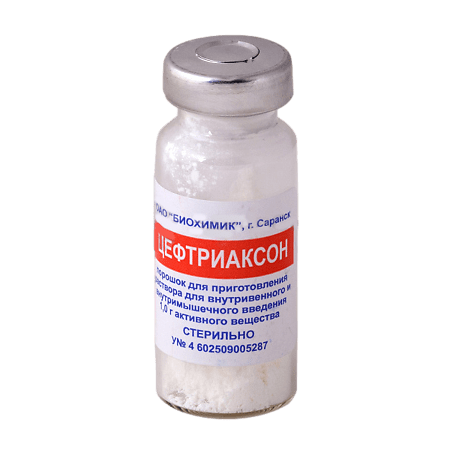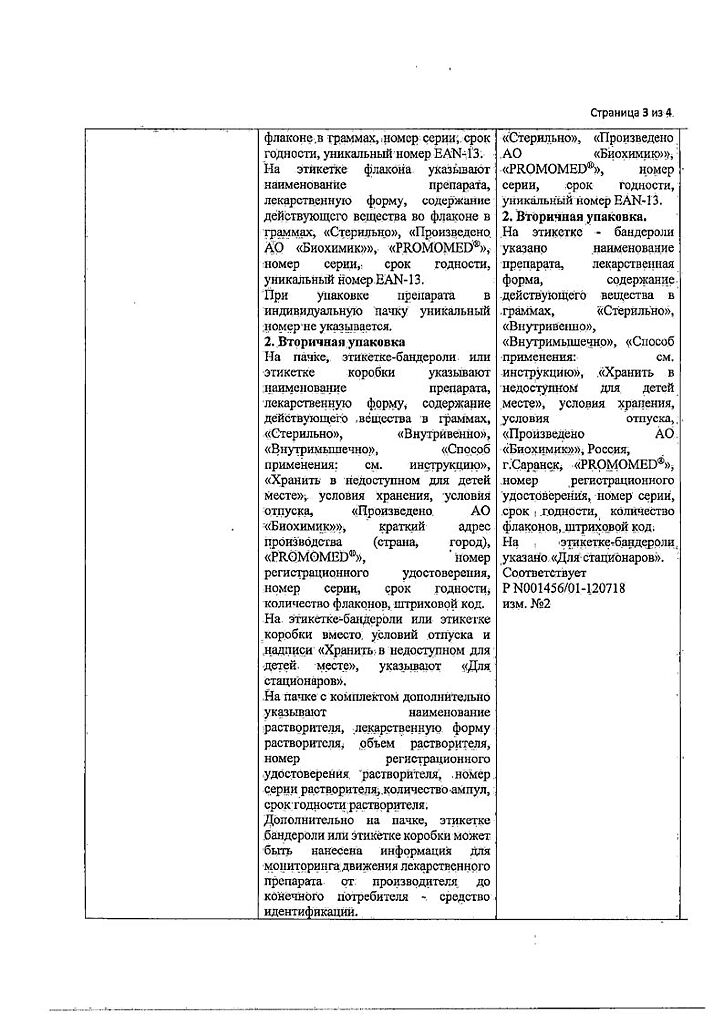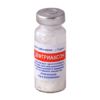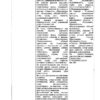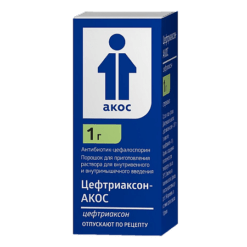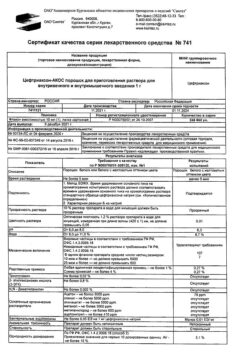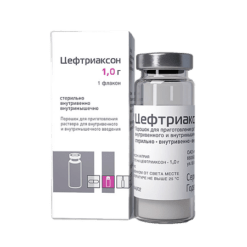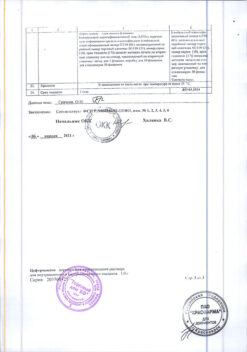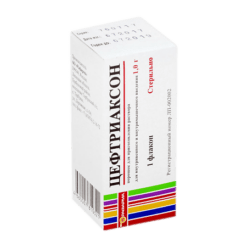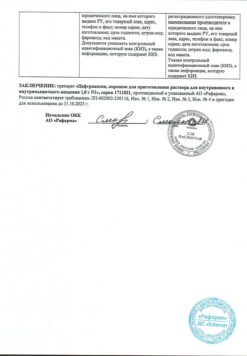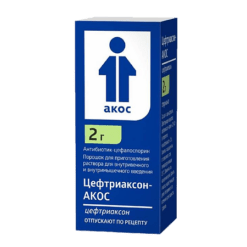No products in the cart.
Ceftriaxone, 1 g
€0.68 €0.57
Out of stock
(E-mail when Stock is available)
Description
Ceftriaxone is a third-generation broad-spectrum cephalosporin antibiotic. It acts bactericidally by inhibiting the synthesis of the cell membrane of microorganisms. In vitro suppresses growth of most gram-positive and gram-negative bacteria. It is resistant against b-lactamases.
Active against Gram-positive aerobic bacteria: Staphylococcus aureus, Staphylococcus epidermidis, Streptococcus pneumoniae, Streptococcus pyogenes, Streptococcus agalactiae, Streptococcus viridans, Streptococcus bovis; gram-positive aerobic bacteria: Aeromonas spp, Alcaligenes spp, Branhamella catarrhalis (forming and non forming beta-lactamases), Citrobacter spp., Enterobacter spp, (some strains are resistant), Escherichia coli, Haemophilus ducreyi, Haemophilus influenzae (including penicillinase-producing strains), Haemophilus parainfluenzae, Klebsiella spp. (including Klebsiella pneumoniae), Moraxella spp, Morganella morganii, Neisseria gonorrhoeae (including penicillinase-producing strains), Neisseria meningitidis, Plesiomonas shigelloides, Proteus mirabilis, Proteus vulgaris, Providencia spp., Salmonella spp. (including Salmonella typhi), Serratia spp. (including Serratia marsescens), Shigella spp, Vibrio spp. (including Vibrio cholerae), Yersinia spp. (including Yersinia enterocolitica), Pseudomonas aeruginosa (some strains); anaerobic bacteria: Bacteroides spp.Bacteroides spp. (including some strains of Bacteroides fragilis), Clostridium spp. (except Clostridium difficile), Fusobacterium spp. (except Fusobacterium mortiferum and Fusobacterium varium), Peptococcus spp, Peptostreptococcus spp.
Methicillin-resistant strains of Staphylococcus spp., Enterococcus spp., Bacteroides fragilis (b-lactamase-producing strains) are resistant to the drug.
Indications
Indications
Bacterial infections caused by sensitive microorganisms:
– peritonitis;
– sepsis;
– meningitis;
– abdominal infections (inflammatory diseases of the gastrointestinal tract, biliary tract, including.Infections of the abdominal tract (inflammatory diseases of the gastrointestinal tract, biliary tract, including cholangitis, gallbladder empyema);
– upper and lower respiratory tract infections (including pneumonia, lung abscess, pleural empyema);
– bone and joint infections;
– skin and soft tissue infections;
– urinary infections (including pyelonephritis, urinary tract infections).Infections of the urinary tract (including pyelonephritis).
– Gonorrhea
– Infected wounds and burns.
Prevention of post-surgical infections.
Infectious diseases in immunocompromised people.
Active ingredient
Active ingredient
Composition
Composition
Powder for preparation of a solution for injection.
1 bottle contains ceftriaxone (in the form of dinatrium salt) 1 g
How to take, the dosage
How to take, the dosage
Ceftriaxone is administered by m/m or intravenously (by stream or IV drip).
In adults and children over 12 years of age the average daily dose is 1-2 g ceftriaxone once daily.
In severe cases or in cases of infections caused by moderately sensitive pathogens, the daily dose may be increased to 4 g (2 g 2 times/day).
In newborns (up to two weeks of age) the dose is 20-50 mg/kg/day.
For infants and children up to 12 years old the daily dose is 20-80 mg/kg.
In children with body weight of 50 kg or more the doses for adults are used.
Doses over 50 mg/kg of body weight should be administered as intravenous infusion (drop infusion). The duration of treatment depends on the nature of the disease.
In bacterial meningitis in infants and young children the initial dose is 100 mg/kg once daily. The maximum daily dose is 4 g.
For the treatment of acute gonorrhea, the dose is 250 mg, once in utero.
To prevent infections in the preoperative and postoperative periods 1-2 g ceftriaxone is administered 30-90 minutes before surgery.
In renal failure (creatinine clearance less than 10 ml/min) the daily dose of ceftriaxone should not exceed 2 g.
In marked hepatic and renal dysfunction, as well as in patients on hemodialysis it is necessary to monitor the concentration of ceftriaxone in blood plasma, since in them the excretion rate may decrease.
Interaction
Interaction
Ceftriaxone and aminoglycosides are synergistic against many Gram-negative bacteria.
Concomitant administration with metronidazole, fluoroquinolones, vancomycin, rifampicin is possible (but not in the same syringe).
When used concomitantly with loop diuretics (e.g., furosemide), renal dysfunction is not observed.
Pharmaceutical interactions
Pharmaceutically incompatible with solutions containing other antibiotics.
Special Instructions
Special Instructions
The drug is administered with caution in newborns (including premature infants) due to the high risk of hyperbilirubinemia, with ulcerative colitis.
In case of concomitant severe renal and hepatic impairment the plasma concentration of the drug should be determined regularly.
Peripheral blood count, plasma and renal function parameters should be monitored regularly during long-term treatment.
In rare cases of ultrasound examination of the gallbladder there are blackouts which disappear after withdrawal (even if this phenomenon is accompanied by right-subcostal pain, it is recommended to continue antibiotic administration and symptomatic treatment).
Contraindications
Contraindications
Hypersensitivity to ceftriaxone; pregnancy (I trimester).
Side effects
Side effects
Allergic reactions: about 1% – urticaria, fever, chills, eosinophilia, rash, itching, exanthema, allergic dermatitis, erythema exudative multiforme, edema, anaphylactic shock.
Digestive system disorders: nausea, vomiting, stomatitis, glossitis, diarrhea, pseudomembranous enterocolitis, cholestasis, increased liver transaminases activity, hyperazotemia, hypercreatininemia, increased urea.
CNS disorders: headache, dizziness.
Hematopoietic system disorders: leukopenia, neutropenia, granulocytopenia, thrombocytopenia, hemolytic anemia.
Local reactions: when administered intravenously – phlebitis, soreness along the vein, when administered intravenously – soreness at the injection site.
Others: superinfection (including candidomycosis, genital mycosis); oliguria, hypocoagulation.
Additional information
| Weight | 0.018 kg |
|---|---|
| Shelf life | 2 years |
| Conditions of storage | In a dry, light-protected place at a temperature not exceeding 20 °C |
| Manufacturer | Biokhimik JSC, Russia |
| Medication form | Powder for preparation of solution |
| Brand | Biokhimik JSC |
Other forms…
Related products
Buy Ceftriaxone, 1 g with delivery to USA, UK, Europe and over 120 other countries.

